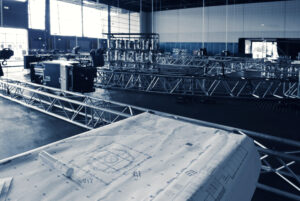
An efficient rigging setup helps ensure everything from lighting to scenic elements operates seamlessly during a performance. Rigging planning is essential for the success of large-scale productions, ensuring smooth operations and preventing potential issues. Proper planning can prevent equipment failure, reduce the risk of accidents and minimize downtime during setup and performance.
You can also avoid costly mistakes and safety concerns that may arise from hasty, uncoordinated systems. Planning gives you time to address venue-specific constraints and potential challenges that could result in delays and technical difficulties.
Ensuring Safety Through Rigging Planning
Protecting your crew, performers and audience is crucial, so creating a detailed rigging plan helps ensure their safety. Without thorough preparation, you may face an increased risk of accidents, equipment malfunctions and other dangerous situations.
Potential hazards in large-scale productions include:
- Improperly secured rigging suspended elements
- Overloaded rigging points
- Disorganized cables and equipment
- Poorly routed electrical systems
- Improper weight distribution in rigging systems
By identifying and addressing those risks in the planning phase, your production team can significantly decrease the likelihood of accidents and create a safer working environment.
Maximizing Efficiency and Minimizing Downtime
Effective rigging planning helps maximize efficiency. Coordinating rigging with other production elements such as lighting, sound and staging can streamline the setup and breakdown processes, reducing downtime between events or scenes.
Here are some tips for coordinating rigging plans effectively:
- Collaborate with lighting, sound and stage management teams to align production goals.
- Create detailed timelines for each aspect of the rigging process to avoid overlap and inefficiency.
- Assign crew members to specific tasks during setup and breakdown.
- Conduct dry runs during rehearsals to test your rigging system before a live performance.
Production teams can prevent costly delays and facilitate smooth transitions between performances by optimizing the workflow.
Adapting to Complex Venue Requirements
Each venue has unique challenges, so there is no one-size-fits-all rigging plan to suit all large-scale productions. Your rigging team should adapt their plans to each venue and consider factors like ceiling height, rigging points, load-bearing capacity and space for staging and audience seating.
For example, older theaters may have limited rigging points, requiring you to find creative solutions to safely hang heavy stage elements. Additionally, outdoor venues may require special considerations for weather-related challenges like wind and rain.
Customizing your rigging plans allows you to integrate diverse production elements without compromising safety or performance quality. Consult the venue staff and ask for a site survey to confirm your rigging setup can accommodate both production needs and the venue restrictions.
Budget Management in Rigging Planning
Creating a rigging plan can help you manage your production budget. Outlining each part of the rigging process allows you to account for labor, equipment and contingency measures. That way you can avoid unexpected costs that may derail your production. Without proper planning, you may incur additional expenses for equipment rentals, last-minute crew hires and emergency repairs.
Taking time to plan out your rigging system allows your team to account for necessary resources, which can prevent financial surprises. You can also secure more cost-effective solutions for equipment and materials by coordinating with vendors and suppliers early in the process.
Manage the rigging planning costs by:
- Requesting quotes for equipment rentals in advance
- Accounting for contingencies in your initial budget
- Collaborating with production partners to share equipment when possible
- Regularly reviewing budget progress against your initial plan
Proper financial planning keeps productions on track and guarantees all rigging needs are met within the allocated budget.
By laying out your rigging process, you can avoid safety hazards, streamline workflows and adapt to the unique challenges presented by different venues. Doing so lays the foundation for a successful and safe event or performance from start to finish.
Specification and Budgeting from Tiffin Scenic Studios
Tiffin Scenic Studios specializes in custom rigging solutions for large-scale productions. Our expert team will help you design a rigging solution that accounts for safety, efficiency and budget requirements. Contact us for more information and schedule a consultation.